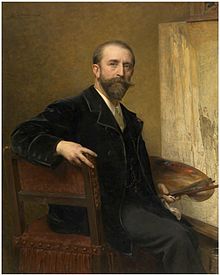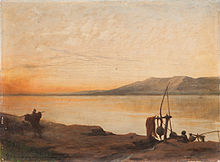Karel Ooms
Karel Ooms (born January 27, 1845 in Dessel , Antwerp province, † March 18, 1900 in Cannes ) was a Belgian painter .
Life
Ooms began his artistic studies in 1857 at the Antwerp Academy , whose pupil he remained until 1865, when he completed it in the studio of Nicaise de Keyser , the director of the same at the time. In 1870 he won the second Roman prize and then trained on long trips through Holland, England, Germany and Italy. He is one of the most capable history and portrait painters of the younger generation in Belgium.
Works
Karel Ooms worked in a variety of genres including portraiture, history painting, landscape painting, and genre painting. Today he is best known for his orientalist and genre paintings and portraits.
Portraits make up about a third of Ooms' known production of 220 works. The models for his portraits came mainly from the wealthy bourgeoisie in Antwerp and the Campine. His self-portrait from 1896 shows the artist holding his palette. The colors on the palette show his fondness for earthy pigments, which was typical of artists like him who worked in the academic tradition.
His career was boosted by the success of his 1876 history / genre picture entitled "The Forbidden Reading" (Royal Museums of Fine Arts of Belgium) . This painting depicts the historical scene of an old man and a young woman bowing over the scriptures . The couple look over the old man's shoulder at something outside of the picture with palpable concern or alarm. The scene probably takes place in the 16th or 17th centuries when Protestants were persecuted for, among other things, their practice of reading the Bible in the language of the people, a practice that was then forbidden by the Catholic Church. One of the reasons for the success of Ooms picture was that the situation of the small minority of Protestants in Catholic Belgium in the late 19th century was seen as parallel to their situation in the 16th century. The original of the painting was immediately acquired by the Belgian state. Ooms made a reduced copy of the work in 1885, presumably for his own use. The composition was also copied by other painters for display in Protestant religious sites and homes, and was also circulated through prints. The composition shows Oom's primary interest in portraiture as the faces of the two figures are at the center of the composition and are clearly painted in more vivid colors and details. A painting with a similar theme of religious persecution is "The Jews in the Middle Ages" (1890, Royal Museum of Fine Arts Antwerp), which deals with the persecution of the Jews.
Ooms painted many other history pictures that showed his interest in the history of his country in the 16th century.
Inspired by his travels to the Middle East, Karel Ooms painted numerous orientalist compositions. Part of it are landscapes that he painted on site. These include works such as "On the Nile" and "View of Jericho". Others depict dancers and public festivals. Karel Ooms also painted a number of works such as "Dreams in the Harem", which reflect the contemporary interest in the subject of the harem and the odalisque in Orientalism. One of his orientalist works - the portrait of an Egyptian woman entitled "The Woman of Cairo" - is part of the Shafik Gabr Collection in Cairo.
Among his more famous pictures are:
- Philip II pays his last respects to his brother Don Juan d'Austria (Antwerp Museum),
- Forbidden Reading, a Protestant reading the Bible with his daughter at the time of persecution (Brussels Museum),
- Judicial investigation at the Plantins printing works in Antwerp
- The dying Duke Alba
- View of Jericho
- Dreaming in the harem
- On the Nile
Web links
| personal data | |
|---|---|
| SURNAME | Ooms, Karel |
| BRIEF DESCRIPTION | Belgian painter |
| DATE OF BIRTH | January 27, 1845 |
| PLACE OF BIRTH | Dessel |
| DATE OF DEATH | March 18, 1900 |
| Place of death | Cannes |


